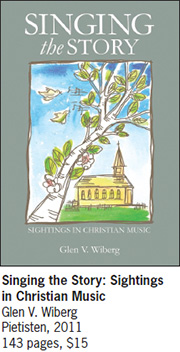review by Philip J. Anderson, professor of church history at North Park Theological Seminary in Chicago.
[divider type=”dotted”]
 Glen Wiberg has written a book, several years in the making, about lovely hymns and stories. One of its author’s favorite adjectives in describing that which grasps and holds a person’s imagination and affection, one’s mind and heart, may be said as well of Singing the Story—it is a “lovely” book. Now in his mid-eighties, Wiberg has left his pastoral and personal imprint on thousands of lives, especially in the Evangelical Covenant Church where he has served as a pastor-scholar in so many facets of its life, notably in areas of preaching, worship, and church music—leading both by example and writing. A key member of the commissions that produced new hymnals for the church in 1973 and 1996, along with a hymn supplement in 1990 (The Song Goes On), he has been close to the pulse of denominational life and public expressions of its praise and proclamation for more than three generations—from an immigrant past to a multicultural present. The book recounts stories with personal remembrances and insights of thirty-seven hymns and spiritual songs, with words and music of each printed, to proclaim “The Story” of the gospel and grace of God in Christ. As one who has reviewed dozens of books, this is the first that I have alternately read (words) and sung (music) out loud. What a delightful and edifying experience!
Glen Wiberg has written a book, several years in the making, about lovely hymns and stories. One of its author’s favorite adjectives in describing that which grasps and holds a person’s imagination and affection, one’s mind and heart, may be said as well of Singing the Story—it is a “lovely” book. Now in his mid-eighties, Wiberg has left his pastoral and personal imprint on thousands of lives, especially in the Evangelical Covenant Church where he has served as a pastor-scholar in so many facets of its life, notably in areas of preaching, worship, and church music—leading both by example and writing. A key member of the commissions that produced new hymnals for the church in 1973 and 1996, along with a hymn supplement in 1990 (The Song Goes On), he has been close to the pulse of denominational life and public expressions of its praise and proclamation for more than three generations—from an immigrant past to a multicultural present. The book recounts stories with personal remembrances and insights of thirty-seven hymns and spiritual songs, with words and music of each printed, to proclaim “The Story” of the gospel and grace of God in Christ. As one who has reviewed dozens of books, this is the first that I have alternately read (words) and sung (music) out loud. What a delightful and edifying experience!
Since 1992 and the passing of his dear friend J. Irving Erickson, consummate Covenant hymnologist who had been writing a regular feature, “How We Got Our Hymns,” for the journal Pietisten, Wiberg has continued the column with the byline “Sightings in Christian Music.” It forms the subtitle of this first book to be issued by its publisher and youthful editors, now based in Seattle, building upon the legacy of the founders in Minneapolis a quarter-century ago. It is hoped to be the first of many books to follow, serving readers, lay and clergy alike in the Pietist traditions. The book then is a compilation of pieces penned and published over the past two decades, each with a theme woven around a specific hymn or hymns with stories of profound theological insight and application in daily living.
Most of the hymns may be found in The Covenant Hymnal: A Worshipbook, and of the thirty-seven, twenty-two represent the Covenant’s heritage, from older Scandinavian to contemporary writers. Of the broader genre, hymns range from the early church with a plainsong tune from the sixth century (“Sing My Tongue, the Glorious Battle”) and Easter texts by eighth-century John of Damascus (“Come You Faithful, Raise the Strain” and “The Day of Resurrection”); to George Herbert’s “Let All the World in Ev’ry Corner Sing” and the liturgical “At the Lamb’s High Feast” (both seventeenth century); to Charles Wesley’s eighteenth-century “And Can It Be That I Should Gain” (which arguably came closest in the past to being the theme song at gatherings of Covenant ministers); to such standards as “Amazing Grace,” “How Great Thou Art,” and “Shall We Gather at the River”; and to the creative contemporary twentieth-century hymn writing of people like the German martyr Dietrich Bonhoeffer (including “Surrounded by God’s Silent, Faithful Angels,” translated by Covenant pastor Steven Swanson) and Fred Pratt Green (“Rejoice in God’s Saints”).
The hymns more specific to the experiences of Covenant people through the years fall into four general areas. First, are those shared more generally in the Swedish Lutheran chorale tradition, as well as the pietistic renewal movement that began in the eighteenth century: for example, “Prepare the Way, O Zion,” “Behold a Host, Arrayed in White” (Norwegian), “If Asked Whereon I Rest My Claim,” “O Let Your Soul Now Be Filled with Gladness,” and “Chosen Seed and Zion’s Children.” Next are some of the beloved songs of Carl Olof Rosenius, Lina Sandell, and Oscar Ahnfelt that embodied the powerful, widespread revival beginning in the 1840s and ’50s, giving birth to the Covenant churches in Sweden, North America, and around the world. These include Rosenius’s “With God as Our Friend” and “Wheresoe’er I Roam,” and Sandell’s “Children of the Heavenly Father” (in three versions), “Thy Holy Wings,” “Day by Day,” and Gracia Grindal’s recent lovely translation of “The Numberless Gifts of God’s Mercies.” Oscar Ahnfelt, the “spiritual troubadour,” wrote tunes for many of these popular songs of the people and then published them.
The final two groupings are specific to Covenant hymn writing during more than 125 years of history. Wiberg understandably has a special fondness for the texts and tunes of Nils Frykman, whose prolific pen captured the heart and soul of a personal encounter with Jesus as friend and brother, including here “How Great the Joy” (Wiberg as one of the translators), “Our Mighty God Works Mighty Wonders,” and “I Sing with Joy and Gladness.” Joel Blomqvist’s “O How Blest to Be a Pilgrim” (also one of the translations of the author), set to Lowry’s tune “Shall We Gather at the River,” along with Swedish Covenant pastor Carl Boberg’s “O Mighty God”—known in its later, shorter paraphrased form in English as “How Great Thou Art”— demonstrate the transatlantic power and popularity of this music. And then there are the recent writings of Covenanters, such as Richard Carlson’s “Come Celebrate the Presence of the Lord” and Jorge Maldonado’s “Seguirte Solo a Tí” (We Worship Only You), with music arranged by Roland Tabell. Wiberg also includes Jeanette Lindholm’s poignant “Unexpected and Mysterious,” whose author grew up in Salem Covenant Church, New Brighton, Minnesota, where Wiberg served as pastor. He speaks of the challenging role of the translator (quoting Martin Marty’s comment that “all translators are liars”) and our indebtedness to those who undertake this kind of stewardship of language, having for decades “carried translations around in his heart.” The book also includes beautiful, fresh, and faithful-to-the-text translations of Sandell’s “Tryggare Kan Ingen Vara” (Children of the Heavenly Father) and Boberg’s “O Store Gud” (O Mighty God) by Mark Safstrom, managing editor of Pietisten and an instructor at the University of Illinois.
This is a book of “citings” as well as “sightings.” There is the scholarly expertise of the hymnologist choosing to cite only certain hymns out of the hundreds available. Capturing the surprising awe and wonder of words wedded to music, Wiberg informs and educates his readers while drawing them into a vivid portrayal of the gospel story accessible to all. The stories he tells along the way reveal the intrinsic experiences of writers and composers, and above all his own, inviting the adding and sharing of stories old and new from each other’s experience. Perhaps the selection process is best revealed by the author’s use of “sightings,” invoking an image of unexpected surprise in the moment, that which fixes the gaze creating an occasion of recollection for the purpose of new insight. These are sightings of the old and familiar with the new and innovative. They invoke both remembrance and discovery in a conversational way. One must read and sing the book to hear Wiberg’s stories and get caught up in the story. They give flesh to the dozens of names cited and sighted in his memory, and many readers will meet in the telling both old and new friends, many now departed. The comprehensive index to the book points to this host of witnesses, and surely its author inherently pleads for the telling of new stories and songs to sing, enlarging the circle.
In the chapter entitled “Thinking Globally, Singing Locally,” Wiberg reminds us that “by music we build bridges that enable us to meet—not as strangers or outsiders, but more than neighbors—as sisters and brothers in Christ.” What better way to do this than in the songs of faith, a collective testimony to the maxim that in order to tell the unfathomable depths and riches of the gospel story, one must first know it, personally having found one’s place in it. Others help us to sing words that are impossible on our own to say, and that is a great gift of grace. The title Singing the Story is especially compelling in this regard since, as Russian poet Joseph Brodsky reminds us, “The song was there before the story.”














